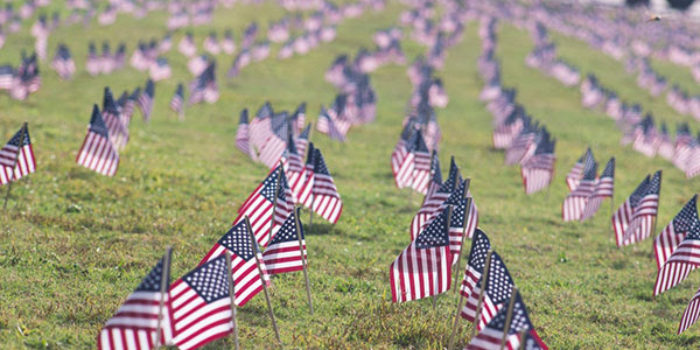Veterans Day: The Contributions of Immigrant Service People
Date: November 11, 2019

Today is Veterans Day, a day that began as Armistice Day on Nov. 11, 1919, the one-year anniversary of the end of World War I, and that was set aside every year thereafter to observe peace. After the Korean War, the date officially became a day to honor all military veterans.
America isn’t the only nation that uses Nov. 11 to honor its veterans. Nor is it the only country to have immigrants serve in its military. However, what makes America stands out in this regard is that it has had so many immigrants to thank for their service. Today, nearly 900,000 immigrants are either veterans or active-duty service members of the U.S. Armed Forces.
“The elders in my family made sure that from a young age I understood the privilege of living in the U.S.,” says Kevin Flores, who arrived in the United States from El Salvador as an undocumented immigrant at age 3 and joined the Marines after high school. Now a lawyer, Flores viewed his military service as a way to thank the country that had taken his family in, “a way to prove myself as a real American.”
The United States government, in turn, granted Flores U.S. citizenship during his first tour of duty in Iraq, in 2007. He later told his alma mater: “In the back of my mind, I knew that in no other country would this be possible: to arrive undocumented and to come back 20 years later not only documented but as an American citizen with a top-secret clearance working for the president of the United States.”
Flores’ story is not out of the ordinary. The United States has a long history of welcoming immigrants into its Armed Forces and of granting them citizenship in return for their service.
Today, however, the U.S. government may be turning its back on veterans like Flores, by delaying citizenship to service members and even deporting veterans who have been honorably discharged. In addition, by rejecting applicants who, like Flores, have lived in the United States since they were children but who, unlike Flores, do not already have legal residency, the military is missing out on the very individuals it needs to meet its recruitment goals and provide much-needed skills in languages, medicine, and cyber-technology.
Immigrant Service Members Today
Looking at the 2017 American Community Survey, we find that:
- 697,711 foreign-born veterans lived in the United States in 2017, comprising 3.5 percent of all veterans;
- 190,198 foreign-born individuals were actively serving in the military in 2017, comprising 4.5 percent of all active-duty service members; and
- Among active-duty military, more than 72 percent of the foreign-born had some college education in 2017, compared with 67.7 percent of the U.S.-born; more than 36 percent of the total number of foreign-born had at least a bachelor’s degree, compared with 18.6 percent of the U.S.-born; and more than 14 percent of the foreign-born had an advanced degree, compared with 11.2 percent of the U.S.-born.
The higher educational achievement of foreign-born recruits is consistent with other studies, which have also found that immigrant recruits enter with higher scores on the Armed Forces Qualification Test and have higher retention rates than U.S.-born recruits.
Naturalization Through Service: a U.S. Tradition
The United States has a long history of encouraging non-citizens to join its Armed Forces. From the Revolutionary War through the 1840s, half of the U.S. military’s recruits were foreign-born. In World War I, when nearly one in five draftees was born overseas, one division from New York City had so many immigrants that its insignia was the Statue of Liberty, symbolizing — as the U.S. Citizen and Immigration Services (USCIS) notes today — “how the same immigrants who sought freedom in the U.S. now served overseas to protect that freedom.”
“Upon entering the Armed Forces, many immigrant service members could not speak English and knew very little about the U.S. military and government,” the USCIS website explains. To help integrate these new Americans, the War Department offered English language and citizenship courses, and in 1918 Congress passed legislation to remove certain restrictions on fast-tracking citizenship for foreign-born service members. In 1919 alone, 128,335 immigrants became naturalized citizens through their military service.
In fact, legislation of one kind or another allowing for the naturalization of non-citizen service members dates back to the War of 1812, when Congress extended immediate citizenship upon enlistment to foreign-born recruits who declared an intent to naturalize.
The nation’s leaders have long agreed that extending citizenship in exchange for military service sends a powerful symbolic message, one that ultimately serves the national defense. By welcoming non-citizens, the military boosts its recruitment numbers, gains diverse and much-needed skills, and builds upon a profound sense of patriotic duty that many new Americans express. Between 1907 and 2018, 745,212 immigrants naturalized through military service, our review of Department of Homeland Security immigration statistics shows.
U.S. Armed Forces Missing out on Additional Immigrant Potential
“I’ve always wanted to be a Marine,” says John Sena, who enlisted in 2015, during his senior year of high school. His twin brother just as desperately wanted to join the Navy. Three of their uncles had served in the U.S. military. But when the recruiter asked for Sena’s Social Security card, Sena learned from his mother he was undocumented.
Through Deferred Action for Childhood Arrivals (DACA) and Military Accessions Vital to the National Interest (MAVNI), Sena was able to enlist. DACA gives qualifying immigrants brought to the country as children the right to temporarily stay and work in the country; Sena had arrived at age 10. And MAVNI allows non-citizens with legal status to enlist in the U.S. military if they possess vital language or cultural knowledge or medical skills; Sena is fluent in Tagalog.
But MAVNI, which was created after 9/11 to address military shortfalls and successfully recruited some 10,400 immigrants with critical skills, hit screening delays in 2016 and was effectively suspended in 2017, leaving Sena and other enlistees in limbo. He is now studying for his nursing degree.
“I’m still standing ready,” he says. “The two greatest things in your life are the day when you are born and the day when you find out why. This is my why. The military is my why.”
Sena is one of about 900 DACA recipients who enlisted in the U.S. Armed Forces through MAVNI. Previous NAE research identified just how valuable he and other Dreamers could be to the nation’s national security efforts. Sena is just one of an estimated 169,000 DACA-eligible individuals who are fluent in one of 45 languages the U.S. military has identified as vital to military success but in short supply among U.S.-born recruits. For example, NAE found that:
- Almost 28,000 Dreamers speak Korean at home;
- More than 9,000 Dreamers speak Russian; and,
- A substantial portion of the Dreamer population speaks a language relevant to ongoing American military engagements: Almost 12,000 speak Arabic, Urdu, Pashto, or Farsi.
Without access to native speakers, the military is often forced to train linguists to meet its language needs. It takes an average native-English speaker two to three years of intense study to learn a complicated language like Arabic, and that speaker may still lack a high degree of cross-cultural competence, something the military has flagged as a high priority since 2005. As U.S. Army Chief of Staff General Raymond Odierno later said, “The best-equipped Army in the world can still lose a war if it doesn’t understand the people it’s fighting.”
Ironically, as Sena waits for an opportunity to serve he is also becoming an increasingly valuable asset. The military faces growing gaps in its supply of healthcare workers. As a nurse, Sena will join more than 19,000 DACA-eligible individuals over the age of 18 who have recently worked as either healthcare practitioners or technical specialists, a group that includes physicians, surgeons, and registered nurses. An additional 22,600 DACA-eligible individuals are trained in healthcare support roles.
On November 12, 2019, the U.S. Supreme Court will hold oral arguments on whether the Trump administration can proceed with plans to wind down DACA. In support of DACA, a group of military service secretaries and military and veterans’ organizations has submitted an amici curiae brief opposing its rescission, stating, among other things, that “the American people also rely on DACA to enhance U.S. national security through military readiness.”
The military representatives go on to point out that DACA enlistees “organized their lives around the commitment to hold themselves constantly ready to serve as soon as their background investigations finished.” Now, after years of delays and program changes, many of these recruits fear that instead of getting to serve the United States they will be kicked out of the country.
Stalling Military Naturalizations and Deporting Veterans Sends the Wrong Message
Between Sept. 11, 2001, and the end of 2013, 284 foreign-born U.S. service members were killed while deployed, a prior analysis by NAE found; more than one in five were from Mexico. One of the first soldiers killed in Afghanistan, in 2003, was Lance Cpl. Jose Gutierrez, a green card holder born in Guatemala who had climbed over a border wall to enter the United States and later, after gaining residency, had joined the military to give back to the country that had saved him and to help fight for its values.
While the United States has historically welcomed immigrants like Gutierrez, Sena, and the thousands of others who are willing to serve in defense of the nation, today, military experts and legislative leaders are concerned that the United States is turning its back on its immigrant veterans, service members, and potential recruits. In an October 2019 oversight hearing by the U.S. House Judiciary Committee, representatives heard evidence that, despite the military’s promises, the government is failing to help military service members apply for citizenship and is deporting veterans for non-violent offenses committed years after they have been honorably discharged.
Approximately 94,000 immigrant veterans today do not have U.S. citizenship. Yet the government cannot say how many veterans it has deported. According to a June 2019 report by the U.S. Government Accountability Office, U.S. Immigration and Customs Enforcement (ICE) is not following its own policies requiring officers to identify and track when veterans have landed in removal proceedings. And as a result of 1996 changes to immigration law, some minor, non-violent offenses are now categorized as aggravated felonies and judges are not able to take a veteran’s status into consideration.
In fact, rather than expedite citizenship, the government is taking longer to naturalize military members than it is civilians — sometimes years instead of months, said Margaret Stock, an immigration lawyer, veteran, and military expert. And military members’ applications are being denied at a higher rate. As a result, Stock said immigration lawyers are advising permanent residents “not to join the military because it will make their naturalization process more difficult.”
These actions, in addition to suspending the MAVNI program, “do not make our country safer,” she told the congressional committee. “In fact, they harm military recruiting, hurt military readiness, and prevent the United States Armed Forces from utilizing the talents of the immigrants who are willing to serve.”


